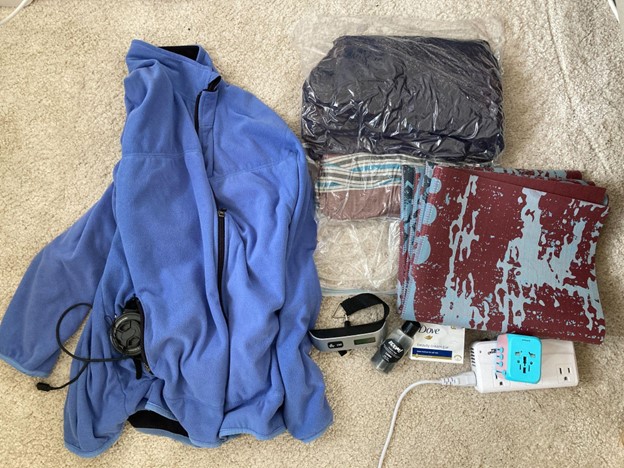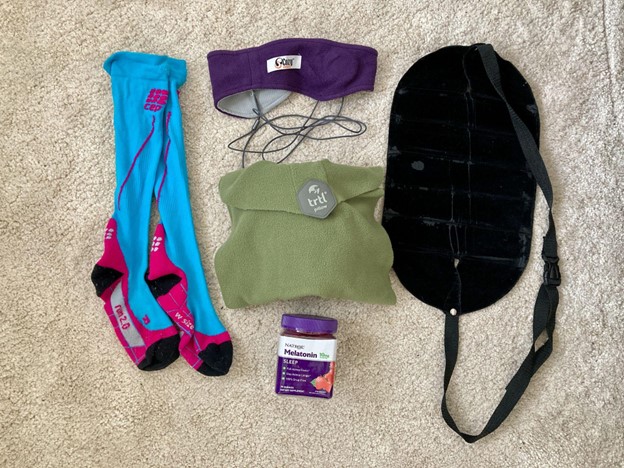If you’re planning a trip to Japan, odds are that you will be taking a plane at some point. Whether the longest leg of your flight journey is only a few hours or 15, you’ll want to pack smart to be as comfortable as possible.
I remember my first intercontinental flight to Taiwan (with a stopover in Tokyo) when I was a university student: I never wanted to do it again. My luggage was overweight, and the dozen hours spent on the plane felt cramped and agonizing. The in-flight movie selection could not make up for the fact that I could not fall asleep.
Now, having taken flights frequently from various international destinations (my longest being a multi-day journey from Bangladesh to the US during the peak time of Covid-induced plane cancellations and reductions), I’m well versed in how to deal with long flights and layovers.
What to Pack Before Your Flight to Japan: Preparing for the Airport

There is a lot to prepare for before your flight even happens. Here are my top product recommendations to optimize your luggage and experience at the airport:
- Luggage scale
I finally bought a portable, digital luggage scale after my second trip to Japan, and I am so glad I did. These hand scales loop a strap around your luggage handle, and you just lift it up to determine the weight in pounds or kilograms. You’ll never be surprised by excess baggage weight again!
- Compression bags
Compression bags are great for fabrics, such as clothes or towels. Fold up your fabrics, place them in the bag, seal the bag, and (depending on which type of compression bag you have) either vacuum out the excess air or roll the bag up to expel the excess air. If you are visiting Japan short-term, I recommend using more roll-up bags because you may not have access to a vacuum cleaner during your trip. However, if you are moving to Japan long-term, I recommend a mix of both vacuum-seal bags and roll-up bags since the vacuum-seal bags tend to compress better. I also bought some compression bags in Japanese 100-yen stores that were of great quality.
- Bar and tablet toiletries
If you are planning to travel light, it may be a good idea to reduce the number of liquids you carry. While you are allowed to take any amount of liquids, aerosols, gels, creams, and pastes in a check-on bag, airlines generally only allow one quart-sized (about 20 cm x 20 cm) plastic bag of these products per person in a carry-on bag. Each container in the plastic bag can hold a maximum of 3.4 oz / 100 mL. This is quite limiting for longer trips (or for people with more complex hygiene routines), so an easy workaround is to find non-liquid products. Try soaps, shampoos, and conditioners in bar forms, and toothpaste in tablet form.
- A jacket with large pockets
With all of my tech gadgets and camera gear, my luggage can easily hit the maximum weight even when I have plenty of space left. Sometimes I can sneak around this by packing heavy objects in my personal item or carry-on, but I have run into problems when, on occasion, the airport workers ask to weigh these. An unofficial workaround here is to pack heavy items into your clothes, and I’ve found a jacket with large pockets can do the trick to hold my camera and lenses, which would otherwise take up a kilogram or a few pounds of precious baggage weight. You will just need to take off your jacket at security, but often not need to remove the items from the pockets once you put it in the security bin.
- Foldable yoga mat
Even though I am not an avid yoga practitioner, I have found it immensely beneficial to bring a foldable yoga mat with me in my carry-on. Why? Airports are not always designed with fliers’ comfort in mind. If my flight is delayed after I arrive at the airport or I have a long transfer time, sitting and stretching on the floor is sometimes more comfortable than sitting on the chairs. I’ve also slept on my yoga mat during a long overnight layover and done some coloring books on the ground. Airport floors can be gross, but a portable yoga mat can make it much more bearable.
- Universal adapter/power converter
Plugs and electrical outlets don’t always work the same in different countries. Japan’s voltage is compatible with North and South American products, but not many other Asian, African, or European countries. Using the wrong voltage without the right converter can make your products charge slowly at best, fry at worst, so be careful. And bringing a charger is useless if you can’t even plug it into an outlet! Although it won’t convert voltage, a universal adapter is always handy to have during any traveling. You will need to research whether you need these products for a trip to Japan or any other country you have a layover in.
Packing for the Plane: What to Use During Your Flight to Japan

You’ve boarded the plane, and now it’s time to get situated. Here are my top product recommendations to make yourself more comfortable:
- Compression socks
Sitting for a long time can wreak havoc on your blood circulation, and wearing compression socks during long flights can help alleviate leg swelling.
- Foot hammock
You might think you look a bit silly–until the people around you realize how smart you are for bringing a foot hammock. I bought one with a buckle that loops around the back of the tray table, and I alternate between resting my feet in the hammock and on the floor. It has been a game-changer for my leg comfort during flights, especially when the plane doesn’t have a quality footrest.
- Neck pillow
A good neck pillow is crucial for me to sleep on an airplane. You have you choice of different styles, from the classic U-shape pillows to the bendy, snake-like ones. My current favorite is the Trtl pillow which holds my neck upright. See which one is the best fit for you!
- Headphones
Like the neck pillow, there are many headphones and earphones to consider on an individual basis. You may want to invest in noise-canceling headphones if you are sensitive to sound, or (my favorite) a headband with headphones built-in for better comfort while sleeping. If you use BlueTooth earbuds, you should look into an airplane adapter to connect them to the in-flight screen.
- Sleep aid
To sleep or not to sleep – that is the question, especially if you are enduring a large time zone change during your flight. Some people suggest timing sleep strategically, others say to sleep when you’re tired–and others recommend against sleeping at all! I personally prefer to sleep during the flight but need a sleep aid to do so. My current favorite is melatonin, and while it’s not illegal in Japan, it’s not readily available to buy in-country. (Remember that if you’re bringing a medication, make sure you check its legal status in Japan and import process before bringing it. For the most up-to-date information, please consult with your embassy and the Japanese government.)
Bon Voyage!

Have a safe journey, and of course: Is there anything else you’d like to add to this list? Let us know!




